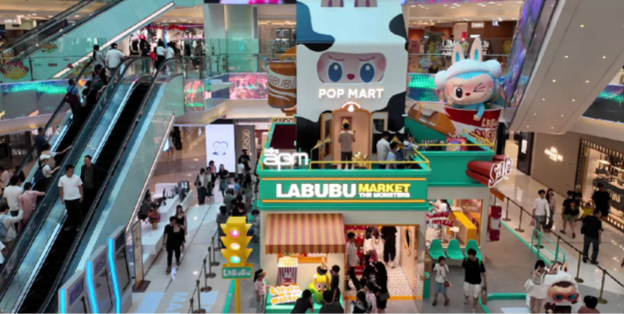LABUBU CRAZE
- Kean Huy Alado
- Oct 5
- 3 min read
By Victoria Rivera
Would you pay over a hundred dollars for a single plush toy under a foot in size? A simple toy inspired by a children’s book has become a worldwide craze that has resulted in themed pop-up shops and cleared stock shelves. Insert Labubus: the brainchild of Kasing Lung’s children’s book “The Monsters.”

Labubu was actually the name of one of the characters in the story, belonging to a tiny and good-hearted race of elves inspired by Nordic folklore. All Labubu characters are girls, and while they try to do their best to help, they often end up making a greater mess.

These silly critters were brought to life by the Chinese toy company “Pop Mart,” which is famous for collaborating with big names like Disney, Nickelodeon and Warner Bros. Most “blind boxes” you find are probably made by them. Labubus were just another one of their hundreds of collaborations until Lisa from the K-Pop girl group “Black Pink” was spotted with one on her bag in a 2024 Instagram post.
One informal picture resulted in a massive surge in popularity, with fans just needing to have one. People became utterly entranced by these tiny, furry critters and their sharp grins.
In Chicago alone, at one Pop Mart store there were people waiting at two in the morning just for a chance to get their hands on one. Buyers can spend on average $70 dollars per box, trying to get the secret, rare toy advertised on the back. That’s if they’re lucky of course, as resellers known as “scalpers” will buy as many of these boxes at retail price to sell for a much higher cost.
D’andre Jamieson, a theatre major in their third year at Barry, finds them to be charming. “I found out about them through TikTok. I think Labubu's are really cute, I personally would love [to have] one. I have never waited in line for a Labubu before, but I think those who buy up all the stock are smart, not going to lie.”
This microtrend far extends beyond the U.S. Lisa’s homeland, Thailand, has had fans traveling to China just to try and buy a Labubu. The recognizability of these toys was so high that in July of the same year they blew up in popularity, a giant Labubu mascot was taken on “tour” around the country as an advertising campaign.
Going a little further down to Singapore also reveals how beloved the toys are, with the People’s Action Party, an organization that helps senior citizens get groceries, dressing a toy in their uniform in a TikTok video.
This level of success has even bred counterfeit Labubus, nicknamed “Lafufus,” that have become so widespread that the Better Business Bureau released a warning to collectors at risk of buying fakes.

While many of these bootleg products are made from poor quality material, or obviously a “poor man’s version of the product,” there have been Lafufus that look eerily similar to the real deal. Some are even almost indistinguishable from the actual product and can be bought for a fraction of the price.
When the product is sold for a price so much higher than its production costs, and fakes can do the job just fine, some critics feel it’s indicative of a greater problem with these trends. “I think it’s just a huge craze that will crash just like beanie babies did,” said freshman Arabella Ford, dual major in English and education. “I honestly find Labubu to be very creepy dolls, and I don’t know why people would want them, but hey I liked beanie babies cause they were cute.... to each their own.
Whether the Labubu remains a cute pop icon or repeats the rise and fall of the Stanley cup, the plush toys remain Pop Mart’s powerhouse. According to Pop Mart’s financial report for the first half of 2025, their revenue has dramatically increased by 204%.
The Labubu brand alone has drummed up over US$670 million— almost twice the amount of money made by Mattel selling Barbie products and $44 million more than Hot Wheels toys. With the sheer marketability of Labubus and their mass appeal, it’s unlikely we’ll be seeing the last of them anytime soon.





Comments